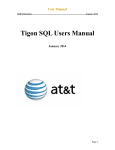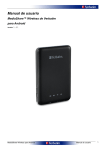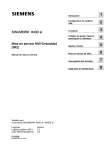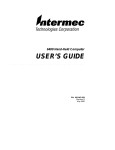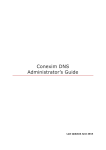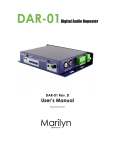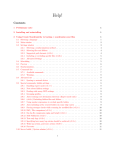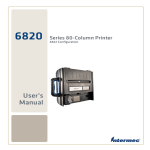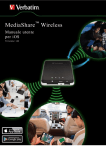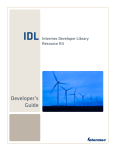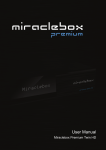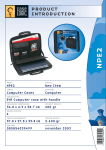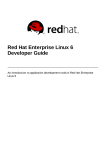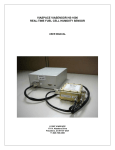Download iMod User`s Manual ENG
Transcript
WWW.INFOPULSAS.LT / [email protected] iMod User's Manual © 2012 TechBase S.A. Technical contact - support.techbase.eu 1/100 TECHBASE (C) iMod User's Manual ENG 2/100 iMod User's Manual Version Document version Creation Date Changes 2.1.0 21.08.2012 Extended base version (XML Tree - Possible Configuration Elements, F.A.Q. chapter supplemented) 1.0.0 21.04.2010 Base version 1.1.0 01.06.2011 Extended base version (1wire, Mbus, WWW chapter, Basic commands, XML Tutorial, Added chapter 8., Appendix A, Appendix B, Appendix C) 2.0.0 01.05.2012 Second version For further information on work with the device, consult the following documents: 1. NPE instructions 2. NxDynamics instructions For further information or in case of finding any innacuracy, please use the technical supprt portal TechBase Support in order to submit an application. This version of the document is a pre-release version, made public due to many requests from our customers. The folliwing content is not official technical documentation and may be used only as auxiliary information. TechBase SA reserves the right to change the contents of the document without notice. © 2012 TechBase S.A. Technical contact - support.techbase.eu 2/100 TECHBASE (C) iMod User's Manual ENG 3/100 Table of Contents 1. 2. 3. 4. 5. 6. 7. 8. 9. 10. 11. 12. 13. 14. 15. 16. 17. 18. Table of contents Preparation for the first start-up Introduction Description of the Connectors Configuration of the Device (NPE) iMod Platform Quickstart Configuration File Structure Modbus Gateway/Router/Proxy Integration of 1-Wire Bus with iMod Platform Mbus Protocol Scripts as Data Source Event Communication Web Visualization Data Registering SNMP iMod SDK iMod PLC F.A.Q. Appendices ● ● ● ● ● ● iMod Configuration Tutorials Example XML Configurations XML Tree - Possible Configuration Elements Useful Tools and Commands Accessories TRM Manual © 2012 TechBase S.A. Technical contact - support.techbase.eu 3/100 TECHBASE (C) © 2012 TechBase S.A. iMod User's Manual ENG Technical contact - support.techbase.eu 4/100 4/100 TECHBASE (C) iMod User's Manual ENG 5/100 Spis treści Preparation for the first start-up ..................................................................................................................................... 7 Connecting the device ........................................................................................................................................................ 8 Connecting the device ...................................................................................................................................................... 8 Method 2. LAN connection .............................................................................................................................................. 10 Telenet connection .......................................................................................................................................................... 12 Checking Firmware Version ............................................................................................................................................ 13 Packages Update with NxDynamics ................................................................................................................................ 13 Introduction ....................................................................................................................................................................... 15 About Document ............................................................................................................................................................. 15 About the device ............................................................................................................................................................. 15 About the NPE system ..................................................................................................................................................... 16 Preparation for the first start-up ................................................................................................................................... 17 Preparation for the first start-up ..................................................................................................................................... 17 1 Screw Connection Description. (C1) ............................................................................................................................. 18 2 Screw Connection Description. (C2) ............................................................................................................................. 19 Configuration of the Device (NPE) ................................................................................................................................. 20 Base Configuration (syscfg) ............................................................................................................................................ 20 Startup Services Configuration (initsrv) .......................................................................................................................... 22 GPRS Connection Configuration ...................................................................................................................................... 23 DynDNS Configuration .................................................................................................................................................... 24 iMod Platform Quickstart ................................................................................................................................................ 25 Initial Information ............................................................................................................................................................ 25 Example Configuration of Receiving Access to Hardware Resources .............................................................................. 25 Configuration File Structure ........................................................................................................................................... 30 Loading a Configuration .................................................................................................................................................. 30 Configuration Verification ................................................................................................................................................ 30 Rules of Construction ...................................................................................................................................................... 30 Modbus Gateway/Router/Proxy ...................................................................................................................................... 34 Modbus Gateway ............................................................................................................................................................. 34 Modbus Router ................................................................................................................................................................ 34 Modbus Proxy .................................................................................................................................................................. 35 Point-to-Point Connection ................................................................................................................................................ 36 Point-to-Multipoint Connection ........................................................................................................................................ 38 TCP/RTU/ASCII Connection .............................................................................................................................................. 40 How to Adjust Configuration to the Poll? ......................................................................................................................... 40 32-bit Parameters ........................................................................................................................................................... 42 Gap / Cycle / Delay / Read Timeout ................................................................................................................................. 43 Forcing Each Write - Property Force ................................................................................................................................ 45 Integration of 1-Wire Bus with iMod Platform ............................................................................................................. 46 Sensor Detection ............................................................................................................................................................. 46 Integration of the Configuration ...................................................................................................................................... 47 Mbus protocol .................................................................................................................................................................... 50 Connecting Mbus meters ................................................................................................................................................ 50 Making Your own MBus Configuration ............................................................................................................................. 52 Scripts as Data Source ..................................................................................................................................................... 56 Example - User_LED readout ........................................................................................................................................... 56 Event Communication ...................................................................................................................................................... 59 Triggering Conditions ...................................................................................................................................................... 59 Action Types .................................................................................................................................................................... 67 Messages Definition ......................................................................................................................................................... 78 Dynamic content definition ............................................................................................................................................. 78 Web Visualization ............................................................................................................................................................. 79 NXDynamics .................................................................................................................................................................... 79 TRM Template ................................................................................................................................................................. 79 Own Website ................................................................................................................................................................... 79 © 2012 TechBase S.A. Technical contact - support.techbase.eu 5/100 TECHBASE (C) iMod User's Manual ENG 4/100 Apache Server Configuration .......................................................................................................................................... Data Registering ............................................................................................................................................................... Into CSV Files .................................................................................................................................................................. SNMP ................................................................................................................................................................................... 82 83 83 87 Example configuraion - Modbus to SNMP ..................................................................................................................... 87 iMod SDK ............................................................................................................................................................................ 90 iMod PLC ............................................................................................................................................................................. 91 XML Tree - Possible Configuration Elements ............................................................................................................... 92 F.A.Q. .................................................................................................................................................................................. 98 © 2012 TechBase S.A. Technical contact - support.techbase.eu 4/100 TECHBASE (C) © 2012 TechBase S.A. iMod User's Manual ENG Technical contact - support.techbase.eu 5/100 5/100 TECHBASE (C) iMod User's Manual ENG 6/100 QuickStart © 2012 TechBase S.A. Technical contact - support.techbase.eu 6/100 TECHBASE (C) iMod User's Manual ENG 7/100 Preparation for the first start-up 1. Power adapter In order to connect the device you need to prepare a power adapter according to the specification, with the minimum parameters of: 12VDC 1000 mA. You can use the DN-20-24 power adapter. 2. Network cable with RJ45 connector Network cable will be used to connect the device to a local area network (LAN) with access to the Internet, or for a direct computer connection. 3. SearchNPE Application The SearchNPE application enables detection of iMOD/NPE devices in the network. You should install this application on the computer. © 2012 TechBase S.A. Technical contact - support.techbase.eu 7/100 TECHBASE (C) iMod User's Manual ENG 8/100 Connecting the device The first step is to connect the power supply. Next, connect the device to a computer or LAN with a network cable. Method 1. Direct connection Direct connection between a computer and the device requires additional network interface configuration. The device should be connected directly to a computer with an Ethernet network cable. The device automatically detects the connection cable type, so that you can use both crossover and standard cables. © 2012 TechBase S.A. Technical contact - support.techbase.eu 8/100 TECHBASE (C) iMod User's Manual ENG 9/100 IP configuration In order to establish a connection you need to configure the IP properly. The IP address should be on the same subnet as the device. The subnet of the computer (and the device) is defined by two parameters: ● ● IP address Subnet mask Ethernet interface of the device has the following default configuration: ● ● IP address: 192.168.0.101 Subnet mask: 255.255.255.0 This information will be used in the next step. Above there are the device default parameters, assuming they have not been changed. The computer must have the following IP configuration: ● ● IP address: 192.168.0.105 Subnet mask: 255.255.255.0 After the above mentioned network settings configuration you will be able to establish a connection with the iMod/NPE device. © 2012 TechBase S.A. Technical contact - support.techbase.eu 9/100 TECHBASE (C) iMod User's Manual ENG 10/100 Method 2. LAN connection Another method is connecting the device to a local area network (LAN). If a router in the network has the DHCP (Dynamic Host Configuration Protocol) service active, the device IP address will be randomly assigned after start. In order to improve searching for the addresses assigned to devices in the local area network the SearchNPE application has been created. After launching the installed application a search window will appear: © 2012 TechBase S.A. Technical contact - support.techbase.eu 10/100 TECHBASE (C) iMod User's Manual ENG 11/100 Next, you need to set the scope of the addresses you search as default for the LAN. For example, for 192.168.5.x network addresses type in '192.168.5.*' Click on the Search button in order to search the network. © 2012 TechBase S.A. Technical contact - support.techbase.eu 11/100 TECHBASE (C) iMod User's Manual ENG 12/100 Telnet connection When you already know the IP address of a device, you can make a telnet connection in order to begin the device startup and configuration. In Windows 7 you need to install the service manually. ● type in telnet IP address in the command-line interface ● The following window appears You need to enter a login and a password in order to log in. The default values are: ● ● Login: user Password: user The entered password is not visible on the screen. ● In order to get Administrator privileges, you need to use the su command Default password: techbase © 2012 TechBase S.A. Technical contact - support.techbase.eu 12/100 TECHBASE (C) iMod User's Manual ENG 13/100 Checking Firmware Version Technical support covers only the latest versions of software. After the first startup, please check if the current firmware version and the latest packages are installed. ● In order to do that, you need to execute the softmgr update firmware command This command checks if a more recent version of firmware is available and it updates the firmware together with the basic packages. After firmware update a reboot of the device with the reboot command is required. Packages Update with NxDynamics ● In order to check if there are any active software packages for the device, you need to log in the NXDynamics interface (pre-installed 30 days trial version) typing the deviceIP/nx into the browser URL address: © 2012 TechBase S.A. Technical contact - support.techbase.eu 13/100 TECHBASE (C) ● ● iMod User's Manual ENG 14/100 After logging in, you need to open the Services tab and check if there are any available updates with the Check Updates button If there are any updates for the packages, you need to use the update option © 2012 TechBase S.A. Technical contact - support.techbase.eu 14/100 TECHBASE (C) iMod User's Manual ENG 15/100 Introduction About Document This documentation describes configuration of the iMod device. Device Version Functionality of an iMod depends on the configuration of the device. In the following part of this document, the term device is used to describe a device based on the iMod platform. Certain hardware resources of a device like e.g., a built-in GSM/GPRS modem are only in selected versions of the device – this is the reason why the '*' is used. The '*' means that the described functionality is applicable only to some versions of the device. Latest Version of Documentation iMod is a dynamically developed product. This way you can receive new functionalities of the device by updating the software. A new version of documentation is released with each software update. The newest version of the documentation can be found at www.a2s.pl or the ftp server: Host: ftp.a2s.pl Login: [email protected] Pass: npe_1m0d About the Device iMod is a telemetry module with an innovative solution based on the concept of three channels: ● ● ● source-channel access-channel message-channel The whole operation logic of the device is described in one descriptive file – MainConfig.xml The following scheme illustrates the system structure of the device: © 2012 TechBase S.A. Technical contact - support.techbase.eu 15/100 TECHBASE (C) iMod User's Manual ENG 16/100 About the NPE system As mentioned before, the platform operates on a NPE device. This means that it is possible to administer the device in a manner consistent with other devices or computers based on the Linux system using a terminal. You can access the hardware resources directly from the NPE system. A detailed description of the NPE and Linux systems is beyond the scope of this document. Further information: - NPE – User's Manual - NxDynamics Manual © 2012 TechBase S.A. Technical contact - support.techbase.eu 16/100 TECHBASE (C) iMod User's Manual ENG 17/100 Description of the Connectors The iMod platform was developed based on the NPE device. NPE has two screw connections (C1, C2) and a front panel. On the front panel there are two monostable buttons and LEDs indicating operation of the device. There is also a number of interfaces available, which are illustrated in the following scheme. Pin Description Element name Description Connector 1 Connector no. 1 (14 pins) Connector 2 Connector no. 2 (16 pins) Sim card slot Sim card slot SD Card Slot SD/MMC Card Slot Ethernet port RJ45 socket Antenna GSM/GPRS antenna input Power LED (PWR) LED power indicator User LED (USR) LED available to the User Status LED (RDY) LED for the device operation status GPRS LED GPRS connection status LED Modem LED (GSM) LED for modem communication status © 2012 TechBase S.A. Technical contact - support.techbase.eu 17/100 TECHBASE (C) iMod User's Manual ENG 18/100 1 Screw Connection Description. (C1) Pin number Label Description 1 VCC (+) Plus [12-30VDC, min. 1000mA] 2 GND (-) Minus 3 CWD Clamps for LEDs protecting the transistor outputs 4 PO4 Open Collector digital output (This is Relay in the 'R' series models) 5 PO3 Open Collector digital output (This is Relay in the 'R' series models) 6 PO2 Open Collector digital output (This is Relay in the 'R' series models) 7 PO1 Open Collector digital output (This is Relay in the 'R' series models) 8 DO2 Open Collector digital output 9 DO1 Open Collector digital output 10 TX1 1. RS-232 Serial port - Transmit data (com0) 11 RX1 1. RS-232 Serial port - Receive data (com0) 12 GND Serial port common ground 13 TX3 3. RS-232 Serial port - Transmit data (com2) 14 RX3 3. RS-232 Serial port - Receive data (com2) The serial ports in the iMod configuration are defined 'com0'(RX1/TX1) and 'com2’(RX3/TX3), respectively. © 2012 TechBase S.A. Technical contact - support.techbase.eu 18/100 TECHBASE (C) iMod User's Manual ENG 19/100 2 Screw Connection Description. (C2) Pin number Label Description 1 B (+) RS-485 Series port (com3) 2 A (-) RS-485 Series port (com3) 3 GND Ground 4 DI1 Digital input 5 DI2 Digital input 6 DI3 Digital input 7 DI4 Digital input 8 DI5 Digital interrupt input 9 DI6 Digital interrupt input 10 DI7 Digital interrupt output 11 DI5 Digital interrupt output or a 1Wire interface 12 GND Ground 13 AI1 0-10VDC analog input 14 AI2 0-10VDC analog input 15 AI3 0-10VDC analog input 16 AIV 0-10VDC analog input See the F.A.Q. chapter if you want to find out more about connection to hardware resources. © 2012 TechBase S.A. Technical contact - support.techbase.eu 19/100 TECHBASE (C) iMod User's Manual ENG 20/100 Configuration of the Device (NPE) The device based on the iMod platform is configured by two configuration files. 1. The (/mnt/mtd) Syscfg file s responsible for the startup options of the NPE system device. This configuration is called the Startup Configuration. 2. The (/mnt/mtd/iMod/config) MainConfig.xml file s responsible for the iMod application configuration. This is called the Application Configuration In order to upload a configuration, you need to restart the iMod platform. You can do that by executing the imod start command from the console or the interface NxDynamics. Base Configuration (syscfg) The startup configuration file is a text file with the following format: Parameter=Value Do not put a space between the '=' sign and the text. Do NOT use quotation marks as well - “Value”. © 2012 TechBase S.A. Technical contact - support.techbase.eu 20/100 TECHBASE (C) Parameter Name iMod User's Manual ENG Description 21/100 Default Value HOST_NAME Parameter which also describes a prompt on login screen. Whitespaces are not accepted techbase HOST_IP IP of a device if it doesn’t receive an address from the DHCP service 192.168.0.101 GW_IP Gateway of the device 192.168.0.1 NET_MASK Subnet mask 255.255.255.0 HOST_MAC Mac address of the device 18:83:C4:04:XX:XX ETH_DNS_1 DNS address if the device doesn’t receive one from the router 8.8.8.8 ETH_DNS_2 Second DNS address if the device doesn’t receive one from the router RTC_RESTORE Variable defining if the time should be synchronized with the RTC after the startup Y OUT_RESTORE Variable defining if the state of digital inputs/outputs should be restored Y DEFAULT_ROUTE Variable defining a default routing ETH START_CONSOLE Startup of the system console on the COM0 serial port(/dev/ttyS0) N START_BLINK NPE system operation indicator on the RDY diode N START_DHCP IP lease from a router Y START_FTP Variable defining if the FTP server starts at the device startup Y START_TELNET Variable defining the telnet server startup Y START_SNMP Variable defining if the SNMP server starts at the device startup N START_SMS Variable defining if the SMS server starts at the device startup Y START_NPESRV Service that helps to find the device in the network with the SearchNPE application Y START_INITSRV Variable defining loading of the start scripts from the /mnt/mtd/init.srv directory Y START_APACHE Variable defining the automatic startup of the apache server Y START_POSTGRESQL Variable defining the automatic startup of the PSQL server Y START_SSH Variable defining the automatic startup of the SSH server Y VPN_SERVER Variable defining the address of the VPN server 10.8.0.1 The PostgreSQL support and some components like e.g., VPN or SSH are not installed on the device. These packages require further installation with the packages manager ( softmgr). © 2012 TechBase S.A. Technical contact - support.techbase.eu 21/100 TECHBASE (C) iMod User's Manual ENG 22/100 Startup Services Configuration (initsrv) Activation of the packages dedicated to the NPE system uses the initsrv mechanism, which enables packages activation in a proper order. Startup Management of Packages During the system startup all scripts from the /mnt/mtd/initsrv directory with names in accordance with the convention are executed. If you want to exclude some of the scripts from the autostart, you only need to change their name - the best way is to add a prefix '_'. For example, you can use the mv command mv S600apache.sh _S600apache.sh After executing this command and rebooting the device the Apache package will not be activated. Launching Order During the installation of particular applications, scripts with a precise name, which are used during the device startup are created in the /mnt/mtd/initsrv directory. The script name is created in the S[1-9999] package convention, where the number 1-9999 indicates the order of launching the scripts. It is recommended not to modify the order assigned to the packages by default. How to Add Own Application to the Autostart Adding own applications, which are run at the system startup is based on creating scripts in the /mnt/mtd/initsrv/ directory with a specified name (in accordance with the order of activation). Next, you need to give the rights to run (with the chmod +x command). Following reboot of the device, the script will be activated after scripts with smaller indexes and before scripts with bigger indexes. Do not double the SXX indexes in the script names. If there are two scripts with identical numbers - they will be activated in the alphabetical order. © 2012 TechBase S.A. Technical contact - support.techbase.eu 22/100 TECHBASE (C) iMod User's Manual ENG 23/100 GPRS Connection Configuration Configuration of basic GPRS connection parameters can be done from the web interface of the device - NxDynamics. In order to get the full access to all the options, you need to modify the section of GPRS connection in the Syscfg directory. Parameter Name Description Format Default Value Y/N Autocomplete depending on the model Variable defining if the GPRS connection is GPRS_AUTOSTART automatic after the device startup(Y) or it is not automatically activated. Y/N/B N GPRS_APN_NAME String empty GSM_BAUD Communication speed with the GSM modem. For the EDGE modems it is the value of 230400 and for the GPRS modems it is the value of 115200. You can check the modem type with the modem info The APN name for the GPRS connection. Activation of the GPRS reconnection process after disconnection. In case of setting the DEAFAULT ROUTE to B, In case of using a number, GPRS_RECONNECT Y/integer it is the indication (in seconds) of the speed of pinging the GPRS_PING addresses in order to verify if there is an active connection. N GPRS_PING_IP_1 IP of the server for checking the GPRS connection 1-255.1-255.1-255.1-255 related to GPRS_RECONNECT. 208.67.222.222 GPRS_PING_IP_2 IP of the server for checking the GPRS connection 1-255.1-255.1-255.1-255 related to GPRS_RECONNECT. 208.67.220.220 GPRS_AUTO_DNS Definition of the Usepeerdns use while a connection attempt. Y GRPS_DNS_1 In case when the GPRS_AUTO_DNS option is set to N, the written DNS records are set for the GSM 1-255.1-255.1-255.1-255 network. 211.138.151.161 GRPS_DNS_2 In case when the GPRS_AUTO_DNS option is set to N, the written DNS records are set for the GSM 1-255.1-255.1-255.1-255 network. 202.101.103.55 GRPS_DNS_3 In case when the GPRS_AUTO_DNS option is set to N, the written DNS records are set for the GSM 1-255.1-255.1-255.1-255 network. 8.8.8.8 GPRS_LOGIN Login for the APN of the GPRS connection String empty GPRS_PASSWORD Password for the APN of the GPRS connection String empty GPRS_PIN SIM card PIN. In case of no PIN on a card this setting will be ignored. Number empty GPRS_DYNDNS Activation of the DynDNS service at every GPRS connection with options in the /etc/inadyn.conf file Y/N N GPRS_MUX GSM modem multiplex mode. Enables using the GPRS session (/dev/ttyS5) and SMS sending (/dev/ttyS6), leaving one channel for any usage (/dev/ttyS7). Y/N Y © 2012 TechBase S.A. AUTO / 1-255.1-255.1-255.1-255 Technical contact - support.techbase.eu 23/100 TECHBASE (C) iMod User's Manual ENG 24/100 DynDNS Configuration iMod has a mechanism for using the DynDNS service for the PPP protocol (GPRS connections). This script uses the InaDynConf library. Further information on this package can be found at: http://www.inatech.eu/inadyn/ The DynDNS service configuration is limited to creating a personal account in the www.dyndns.com service and editing the /mnt/mtd/iMod/config/inadyn.conf file. This is an example configuration: # DynDNS configuration --username test --password test alias test.homeip.net iterations 1 © 2012 TechBase S.A. Technical contact - support.techbase.eu 24/100 TECHBASE (C) iMod User's Manual ENG 25/100 iMod Platform Quickstart Initial Information In order to start with the iMod platform, you need to prepare the following software improving building of the configuration and verification of the iMod engine operation. This is the list of the necessary software: ● ● ● ● ● ● ● ● FTP client (e.g., FreeCommander) XML files editor (e.g., Notepad++) iMod configuration parser (available here for download) Internet browser (not earlier than: IE9, FF6, Opera 10, Chrome 8) Modbus master type software (e.g., modbus poll) Modbus slave type software (e.g., Modbus simulator) Telnet client (e.g., Putty) SearchNPE The following examples illustrate an optimal configuration of the work environment with the iMod platform. All of the examples below and video tutorials showing the usage are available on the FTP server. Host: ftp.a2s.pl Login: [email protected] Pass: npe_1m0d Example Configuration of Receiving Access to Hardware Resources The iMod platform enables multiple access both to the internal hardware resources and the external parameters. In case of building a proper configuration the data is stored in a database, available via a web template, Modbus protocol and SNMP. A few ways of gaining access to hardware resources are presented as an introductory example, this will be useful in further learning about the iMod platform operation. © 2012 TechBase S.A. Technical contact - support.techbase.eu 25/100 TECHBASE (C) iMod User's Manual ENG 26/100 I/O access from NxDynamics Each iMod device is delivered with a pre-installed trial version of the NXDynamics interface (The possibility of a free interface update ends after 30 days). It enables an easy preview of hardware resources and control of digital outputs via the web interface. ● ● ● Type: <IP of the device>/nx into the browser URL address bar Log into the website and click on the I/O tab On the screen you will see a hardware resources chart, which you can control with your mouse. The NxDynamics interface uses a dedicated message channel with an application for interrupt support of hardware resources. It provides almost instant refresh of the parameters on the web without burdening bandwidth. Available hardware resources and the precise look of the chart may differ depending on the version and model of the device. Videotutorial: www.youtube.com/watch?v=psAXI8W3nTw © 2012 TechBase S.A. Technical contact - support.techbase.eu 26/100 TECHBASE (C) iMod User's Manual ENG 27/100 I/O Access Via Modbus TCP Protocol After uploading an appropriate configuration you can gain access to all the input/output resources that the platform is equipped with, using the Modbus protocol. In order to gain access to the resources you need to upload the MainConfig.xml directory containing definitions of all the hardware resources for location of the /mnt/mtd/iMod/config configuration and reboot the iMod. A complete example configuration can be found on the FTP server. Configuration File Structure The iMod configuration is saved in the MainConfig.xml file located in the /mnt/mtd/iMod/config/ directory on the device. Upload the configuration which enables access to the hardware resources using the Modbus TCP protocol. 1. 2. 3. 4. 5. 6. 7. Run Notepad++ Enable the NPP FTP plugin Configure the FTP connection with the device Download current configuration of the device /mnt/mtd/iMod/config/MainConfig.xml Download current configuration from the /mnt/mtd/iMod/config/example1-hardware_access.xml device Copy the content of the example1-hardware_access.xml file into the MainConfig.xml file. Save the configuration on the device (It is recommended to copy the previously uploaded configuration into the configuration parser in order to check if the configuration is correct. (This time you don’t have to do that, because you have a guarantee that the prepared example files are correct) 8. Log into the device with a console or the NxDynamics interface 9. reboot the iMod with the imod start command Video tutorial - points 1. - 7.: www.youtube.com/watch?v=1ouYOkJQvBU?medium © 2012 TechBase S.A. Technical contact - support.techbase.eu 27/100 TECHBASE (C) iMod User's Manual ENG 28/100 Startup of the Platform The iMod platform runs automatically after activation of the NPE firmware. If you modify the configuration, you need to reboot the iMod. You can do that by writing the imod start command from the command line. There are different iMod startup modes - debug and trace which are useful in case of developing own configurations. The iMod platform operation can be previewed in real time through so called live-logs. In order to preview with a live-log, execute the following commmand: tail -f /mnt/data/logs/iMod.log In case of a startup of the platform in the trace mode, you will see each parameter change and each supported question together with the sent answer. Operation Verification Verify if you can connect to the device with the modbus protocol. 1. 2. 3. 4. 5. Run a modbus master type appllication (np. modbus poll) Configure polling (2. parameters from the address 100) Configure the connection setting with the device (Device id:1, Default IP: 192.168.0.101, default TCP port: 502) Start polling Check if the hardware resources on the NxDynamics chart change in accordance with the changes made by the actions performed via the TCP modbus protocol Video tutorial illustrating points 1-5 www.youtube.com/watch?v=6tKCJUZSQMo Extensive Hardware Resources File Depending on the version of the device, you can extend the example configuration with additional parameters. On the FTP server you can find the example1-hardware_access-extended_version.xml configuration for the NPE 9000 series. © 2012 TechBase S.A. Technical contact - support.techbase.eu 28/100 TECHBASE (C) iMod User's Manual ENG 29/100 I/O Access with Telnet Console The NPE platform provides two access levels to hardware resources - with the uploaded into firmware of the device 'npe' application, which uses hardware resources library of the NPE device - via the npe-service application, which provides permanent readout of hardware resources. Readout with 'npe' Application In order to use the built in 'npe' application, you need to log into the device as a super-user (root). The npe command is visible from any place on the device. Readout is done by assigning one of the inputs/outputs to the variable '?' and calling the variable with the echo $? command. npe ?DO1; echo $?; More examples of the NPE application use can be found in the application manual on the device. Just type the following command: npe [ Aplikaja npe - manual ] Readout with npe_service The NPE platform has a built in application for the event support of hardware resources. In order to preview or control the I/O in NPE you need to refer to the npe-srv-client application. Example readout of a digital output: [root@techbase /]# npe_srv_client -i DO1 Example writing of a digital output: [root@techbase /]# npe_srv_client -i DO1,”0” Video tutorial illustrating access to hardware resources from a console: www.youtube.com/watch?v=OyLaq0gEHGk © 2012 TechBase S.A. Technical contact - support.techbase.eu 29/100 TECHBASE (C) iMod User's Manual ENG 30/100 Configuration File Structure Configuration file is written in the XML format. The iMod engine reads a configuration from the MainConfig.xml file in /mnt/mtd/iMod/config/ directory. Loading a Configuration Configuration is loaded via the FTP protocol into /mnt/mtd/iMod/config directory. While using other programs, remember to copy onto NPE platform in binary mode. Configuration Verification Each configuration and implemented changes should be verified in 3 stages. 1. User PC verification with configuration parser. 2. NPE platform verification with iMod built-in parser - it is done automatically after executing the imod start command. 3. Validation of configuration operation (to check if the implemented changes comply with your needs) with dedicated use cases. It is crucial that the configuration is correct and optimal. Only then will iMod make full use of the NPE platform hardware resources. In order to check if it operates properly, see if there is no WARN and ERROR type information in the iMod.log file in normal mode. Rules of Construction General Rules Configuration consists of elements. Each element must be closed. Closing the elements may be done in two ways. e.g., 1. Opening and closing an element in one line: <element /> 2. Opening and closing an element in two lines: <element> ... </element> An element may have a property. Possible values of a property strongly depend on an element they are in. The use of properties is precisely written out in chapters describing specific functionalities e.g., <property name="device-id" value="3" /> Other elements may be nested in an element. e.g., <element> <element1 /> </element> © 2012 TechBase S.A. Technical contact - support.techbase.eu 30/100 TECHBASE (C) iMod User's Manual ENG 31/100 All the elements must be inside the imod element e.g., <imod version="1.0.0" > ... </imod> Elements may be grouped by closing them in a group element with a name e.g., <group name="Channel definitions"> ... </group> Configuration is not case sensitive. Channel Definition iMod logic is based on a three channels principle: ● ● ● Source-channel - data source channel Access-channel - data access channel Message-channel - event-triggered communication Name Each channel must hold a separate name, which will be used in channel identification parameters. e.g., <access-channel name="Modbus_S1"> Protocol Each channel must contain a protocol element which defines the protocol. e.g., <protocol name="MODBUS"/> Other Elements Definition of other elements depends on a channel type and a protocol. e.g., <access-channel name="Modbus_Master"> <protocol name="MODBUS"/> <port>"ET-502-TCP"</port> © 2012 TechBase S.A. Technical contact - support.techbase.eu 31/100 TECHBASE (C) iMod User's Manual ENG 32/100 </access-channel> <source-channel name="Modbus_Slave"> <protocol name="Modbus"/> <port>"com3-1200-8N1"</port> <gap>0</gap> <cycle>5s</cycle> </source-channel> <message-channel name="DiffrenceCounter"> <protocol name="SCRIPT"/> <port>"/mnt/mtd/iMod/config/"</port> <recipient>"difference"</recipient> </message-channel> Parameters Definition Parameter Element Each parameter contains a series of elements, defining where data is taken from and a method of data access. It is possible to define a parameter which is not related to the Source-channel. Such a parameter is called dummy. It enables to create empty registers on the platform for any use. In the parameter definition of an element you can declare its type as well. There are the following types of parameters: ● ● ● ● ● int16 - Integer. A whole number from −32 768 to +32 767 int32 - Double Integer. A whole number from −2 147 483 648 to +2 147 483 647 word16 - A whole number from 0 to 65 535 word32 - A whole number from 0 to +4 294 967 295 real32 - A floating-point number from 3.4e-038 to 3.4e+03 An example parameter type definition: <parameter type="real32" > ID Element The value of the ID element must be unique in the entire configuration. It is alphanumeric data type. e.g., <id>"ExampleID1"</id> Source-channel Element Data source assigned to a channel parameter. The assigned channel is identified by providing its name. You should provide the parameter-id properties along with the name. The parameter-id format strictly depends on a communication protocol assigned in the channel definition. Only 1 source-channel element may be assigned to each parameter. It is an optional element, so you may also omit its definition. e.g., Data source as an analogue input I <source-channel channel-name="NPE_io" parameter-id="AI1" /> Data source from an external modbus device from a 101 register: © 2012 TechBase S.A. Technical contact - support.techbase.eu 32/100 TECHBASE (C) iMod User's Manual ENG 33/100 <source-channel channel-name="ModbusSlave" parameter-id="101" /> Data source from a 1-wire sensor: <source-channel channel-name="OneWire" parameter-id="28E616CA020000:temperature9"/> Access-channel Element Assigning a parameter to the access-channel. An assigned channel is identified by providing its name. Many elements may be assigned to one access-channel parameter. You should provide the parameter-id properties along with the name. The parameter-id format strictly depends on a communication protocol assigned in the channel definition e.g., for a modbus parameter the parameter-id is the starting address of the parameter. <access-channel channel-name="ModbusSlave" parameter-id="101" /> Event Element Each parameter may include the event element. Further information on this element may be found in the event communication chapter. This element is responsible for additional actions during values read-out. Optional Elements A number of elements improving clarity of the configuration may be assigned to each parameter. Additionally, content of the elements will be saved together with the parameter value in the SQLite3 default database - modbus.db. It enables further download of the values and presenting them on the website in an easy way ● ● ● ● ● ● Offset - displacement Scale - scale Description - an element enabling adding a parameter description Label - an element enabling labeling a parameter minVal - an element defining a minimum allowed parameter maxVal - an element defining a maximum allowed parameter Definition of Message Content Further information on communication and message content is in the Event-triggered definition chapter (messages definition). Configuration Validation Before loading a configuration to a device you may validate the configuration on your computer. In order to do that, you need to download a parser from an FTP server for iMod clients or iMod product from the following website www.a2s.pl. iMod configuration parser © 2012 TechBase S.A. Technical contact - support.techbase.eu 33/100 TECHBASE (C) iMod User's Manual ENG 34/100 Modbus Gateway/Router/Proxy The iMod can perform functions of a modbus gateway, router or a proxy device at the same time. In the following chapter you will find a definition of the mentioned functionalities with configuration examples. Modbus Gateway Information from Modbus slave (Modbus RTU, Modbus ASCII) devices received through a serial port is transmitted to the Ethernet network (Modbus TCP). Modbus Router ● ● Modbus slave devices can work in the Ethernet network. Modbus master device can communicate via serial port. © 2012 TechBase S.A. Technical contact - support.techbase.eu 34/100 TECHBASE (C) iMod User's Manual ENG 35/100 Modbus Proxy ● ● ● Readout from slave type devices. Write in the buffer. Transmitting data to modbus masters. © 2012 TechBase S.A. Technical contact - support.techbase.eu 35/100 TECHBASE (C) iMod User's Manual ENG 36/100 Point-to-Point Connection Example Configuration Structure This example demonstrates a method of communication of the iMod device with another device supporting the Modbus RTU protocol. An example configuration example2-modbus_proxy.xml can be found in the device directory: /mnt/mtd/iMod/config/examples/ Add Source-channel First, you need to define a serial port for the readout. This is a structure of the configuration of a channel supporting the Modbus RTU protocol on the COM3 port: <source-channel name="Modbus_M1"> <protocol name="MODBUS"/> <port>"com3-19200-8E1"</port> <gap>0</gap> <cycle>6</cycle> </source-channel> The parameters of the serial port are as follows: ● ● ● ● ● ● COM port: 3 RS-485 baudrate: 19200 baud/s datatbits: 8 datatbits: Even stop bits: 1 protocol type (default): Modbus RTU The above configuration contains only required elements. Remaining elements such as modbus ID of the device or response to a request time are default. Further information on the possible elements in defining the Modbus type source-channel can be found in the XML chapter. © 2012 TechBase S.A. Technical contact - support.techbase.eu 36/100 TECHBASE (C) iMod User's Manual ENG 37/100 Add Access-channel After defining the data source, add the definition of access to the data. In this example it is the access via the Modbus TCP protocol. <access-channel name="Modbus_S1"> <protocol name="MODBUS" /> <port>"ET-502-TCP"</port> </access-channel> Add Parameter (modbus registers) Define the readout from selected modbus addresses and assign them to modbus addresses in the iMod. In order to do that, you need to include a reference to access and source-channel in the <parameter> structure: <parameter> <id>1</id> <source-channel channel-name="Modbus_M1" parameter-id="1"/> <access-channel channel-name="Modbus_S1" parameter-id="1"/> </parameter> The Modbus RTU register with the address of the 1 device connected to the COM3 port is converted to the TCP Modbus register with the same address. The following example enables users to buffer values and control a parameter in the external device supporting the modbus protocol. The above configurations also contains only required elements. In iMod you can easily choose a function code that will be used for polling an external device, set a byte order reverse in the 32-bit parameters, force write of every same value, etc. Further information can be found in the XML chapter. Configuration Verification 1. 2. 3. 4. 5. Connect iMod with a computer with the RS-485 serial port (e.g., with a converter ATC-820) Download modbus slave application (e.g., mod_RSsim_eth) Run modbus master software (e.g., modbus poll) Run modbus slave output with register 1 simulation (0x03 function code) Read and write values several times Video tutorial illustrating points 4-5: www.youtube.com/watch?v=YsHrvpR_RS8 © 2012 TechBase S.A. Technical contact - support.techbase.eu 37/100 TECHBASE (C) iMod User's Manual ENG 38/100 Point-to-Multipoint Connection In the distributed networks there are often many slaves. This chapter shows how to build a configuration for a point-to-multipoint network. Modbus TCP - Many Slave Type Devices In the previous configuration there was an example of how to read parameter values from the Modbus Slave devices. The configuration contains a minimum configuration, which is required. Part of the not configured settings took default values. These included e.g., the device-id element. How To Change iMod Modbus ID The device ID enables its identification among other devices. iMod has a default ID = 1. You can change that by adding a property to the access-channel. Example iMod ID change to ID = 2. <access-channel name="Modbus_S1"> <protocol name="MODBUS" /> <port>"ET-502-TCP"</port> <property name="device-id" value="2" /> </access-channel> © 2012 TechBase S.A. Technical contact - support.techbase.eu 38/100 TECHBASE (C) iMod User's Manual ENG 39/100 How to Set ID for Modbus Slave Device (modbus address) There are two ways of an ID change for a modbus slave. Deafult ID change for a Modbus Slave Default modbus address for a source-channel (slave type devices) is 1. However, you can change the default setting by writing an ID in the source-channel definition: <property name="device-id" value="NEW_ID"/> Example source-channel with a changed default modbus address to address = 2: <source-channel name="Modbus_M1"> <protocol name="MODBUS"/> <port>"com0-19200-8E1"</port> <property name="device-id" value="2"/> <gap>0</gap> <cycle>1</cycle> <delay>100ms</delay> </source-channel> Device ID Change in Parameter If you have several devices, you need to enter the ID which the parameter refers to, for parameters with a modbus address other than default (modbus register). The definition of a modbus address needs to be included in the <source-channel> element. Below there is an example parameter definition from a modbus device with the address 2 and register 3: <parameter> <id>"2-3"</id> <source-channel channel-name="Modbus_M1" parameter-id="3" > <property name="device-id" value="2"/> </source-channel> </parameter> © 2012 TechBase S.A. Technical contact - support.techbase.eu 39/100 TECHBASE (C) iMod User's Manual ENG 40/100 TCP/RTU/ASCII Connection iMod supports the modbus protocol in its three varations ASCII, TCP and RTU. In order to define a modbus type protocol, you need to include the property type <protocol> in the element. <protocol name="MODBUS"> <property name="type" value="RTU" /> </protocol> Example Modbus ASCII protocol declaration: <source-channel name="Modbus_M1"> <protocol name="MODBUS"> <property name="type" value="ASCII" /> </protocol> <port>"com0-19200-8E1"</port> <gap>0</gap> <cycle>1</cycle> <delay>100ms</delay> </source-channel> A change in the protocol type is made in an identical way both for the data source-channel and data access-channel. How to Adjust Configuration to the Poll? Modbus RTU / Modbus ASCII For Modbus RTU the frame is built of the following fields: 1st byte 2nd byte 3rd-4th byte 5th-6th byte 7th-8th byte Device-id (modbus address) Function code Initial register Number of registers for readout Checksum Example frame: 0A 03 00 00 00 0A B6 Device-id=10 Function code= 0x03 Initial register=0 10 registers Checksum Adjusting 1st Byte The modbus address is set by adding the following element: <property name=„device-id” value=„XX” /> Further information can be found in the Point-to-multipoint connection section. © 2012 TechBase S.A. Technical contact - support.techbase.eu 40/100 TECHBASE (C) iMod User's Manual ENG 41/100 Adjusting 2nd Byte - Functions Codes There are four readout function codes in modbus: Function code Name Function description 0x01 Coil Modbus register for reading and writing binary parameters (0/1) 0x02 Discrete Modbus register for read only binary parameters (0/1) 0x03 Output Modbus register for reading and writing 0x04 Input Modbus register for read only. In iMod you change the sent function code in the poll, by adding a property element named „varspace” e.g., <property name="varspace" value="coil" /> The name 'varspace' is used, because in older devices function code also meant memory area from which a parameter was taken. Example definition of a coil type modbus register. <parameter> <id>"1"</id> <source-channel channel-name="Modbus_M1" parameter-id="1"> <property name="varspace" value="coil" /> </source-channel> </parameter> Adjusting the 3rd and 4th byte - Initial Register A shift of registers may occur in the modbus devices. If (in the modbus slave device documentation) there is a description that a parameter X is in the register at the N number, it may mean that it should be defined as N+1, N-1 or simply N in the iMod. The initial value is taken from the parameter and its 'parameter-id’ element defined in the source-channel. i.e.,: <parameter> <id>"1"</id> <source-channel channel-name="Modbus_M1" parameter-id="100"/> </parameter> means sending a poll with the initial address: 00 64 Adjusting the 5th and 6th byte - Number of Registers for Polling iMod internally groups the read parameters. It finds the initial address and adjusts polls together with the number of registers to read, in such a way to gather as much data in the smallest number of polls. Adjusting Checksum iMod automatically calculates the correct checksum for each poll. © 2012 TechBase S.A. Technical contact - support.techbase.eu 41/100 TECHBASE (C) iMod User's Manual ENG 42/100 32-bit Parameters Part of the modbus devices has 32-bit parameters in the registers table. iMod enables definition of such registers by changing a parameter. <parameter type="real32"> ... When defining a 32-byte parameter, you need to remember to increment the following access-channel parameter ID by two. There are five types of parameters in iMod: Parameter type Description int16 16-bit Parameter int32 32-bit Parameter word16 16-bit Parameter with no sign (unsign integer) word32 32-bit Parameter with no sign (unsign integer) real32 32-bit Parameter with a floating point value Example parameter definition: <parameter type="int16"> <id>"1"</id> <source-channel channel-name="Modbus_M1" parameter-id="1" /> <access-channel channel-name="Modbus_S1" parameter-id="1" /> </parameter> <parameter type="int32"> <id>"2"</id> <source-channel channel-name="Modbus_M1" parameter-id="2" /> <access-channel channel-name="Modbus_S1" parameter-id="2" /> </parameter> <parameter type="word16"> <id>"3"</id> <source-channel channel-name="Modbus_M1" parameter-id="4" /> <access-channel channel-name="Modbus_S1" parameter-id="4" /> </parameter> <parameter type="word32"> <id>"4"</id> <source-channel channel-name="Modbus_M1" parameter-id="5" /> <access-channel channel-name="Modbus_S1" parameter-id="5" /> </parameter> <parameter type="real32"> <id>"5"</id> <source-channel channel-name="Modbus_M1" parameter-id="7" /> <access-channel channel-name="Modbus_S1" parameter-id="7" /> </parameter> © 2012 TechBase S.A. Technical contact - support.techbase.eu 42/100 TECHBASE (C) iMod User's Manual ENG 43/100 Property 'inverse' Very often, there is an issue with value interpretation of the 32-bit parameters. If the 32-bit parameters have incorrect value, try to add bit inversion before calculating the value in such a way that the other 16 bits are at the front. You can do that with the <property> element called inverse. <property name="inverse" value="true" /> The information on inversion of parameters, can be both in the source-channel and access-channel element. Example definition: <parameter type="real32"> <id>"5"</id> <source-channel channel-name="Modbus_M1" parameter-id="7"> <property name="inverse" value="true" /> </source-channel> <access-channel channel-name="Modbus_S1" parameter-id="7" /> </parameter> Gap / Cycle / Delay / Read Timeout Polling frequency parameters are linked with the modbus protocol. The section below in short describes polling parameters available for modification. Example source-channel containing definitions of all elements related to polling on the channel. <source-channel name="Modbus_M1"> <protocol name="MODBUS"/> <port>"com3-19200-8E1"</port> <gap>0</gap> <cycle>1</cycle> <delay>100ms</delay> <read-timeout>100ms</read-timeout> </source-channel> Cycle The <cycle> parameter defines the frequency of the modbus addresses series update. This is a required element. The default value unit is a second. Gap © 2012 TechBase S.A. Technical contact - support.techbase.eu 43/100 TECHBASE (C) iMod User's Manual ENG 44/100 The <gap> parameter defines the min. require silent at the end of a cycle. This is a required element. The default value unit is a second. Delay The <delay> parameter defines an interval between the modbus polls. Declared total values are seconds. The delay parameter is optional, lack of the parameter results in assigning a default value of 0ms Read-timeout The <read-timeout> element defines time the iMod platform waits for a response from a device. This is an optional element. The default value is 1000ms. © 2012 TechBase S.A. Technical contact - support.techbase.eu 44/100 TECHBASE (C) iMod User's Manual ENG 45/100 Forcing Each Write - Property Force There are modbus elements which perform actions after update parameter value. iMod has an internal logic that does not forward the write command if the parameter value does not change. However, you can force such a transmission by adding a 'property’ element. <property name="force" value="true" /> Example definition with a 'force’ property implementation: <parameter type="int32"> <id>"1"</id> <source-channel channel-name="Modbus_M1" parameter-id="1" /> <access-channel channel-name="Modbus_S1" parameter-id="1" > <property name="force" value="true" /> </access-channel> </parameter> © 2012 TechBase S.A. Technical contact - support.techbase.eu 45/100 TECHBASE (C) iMod User's Manual ENG 46/100 Integration of 1-Wire Bus with iMod Platform The following chapter describes the way of using the iMod system for collecting information from a distributed system of sensors, transmitters, reed switches, etc. connected to the 1-Wire bus. Sensor Detection First check if the sensors were detected by the one-wire server with the following command: [root@techbase /]# owlist info id: 28E616CA020000 chip: DS18B20 desc: THERMOMETER value: 24.125 If the sensor has been detected, scan the one-wire bus with the imod scan onewire command. This command results in generating a configuration containing parameters together with a readout from sensors and sharing the results via the modbus protocol in the ONEWIREScan.xml directory. [root@techbase /]# imod scan onewire iMod Tiger Engine [Version 1202171418] Stopping iMod daemon. Please wait... Killing iMod daemon: Succeeded 12:01:17,963 [main] INFO - Starting iMod Tiger Engine Version 1203271136, Xml Config Version 1.1.53 12:01:18,511 [main] INFO - Parsing the file: /mnt/mtd/iMod/config/MainConfig.xml 12:01:20,295 [main] INFO - Parsed the configuration file in: 1766 ms 12:01:21,155 [main] INFO - Interpretation took: 849ms 12:01:29,679 [main] INFO - Running Scanner... 12:01:29,750 [main] INFO - OneWire scanner initialization... 12:01:30,252 [main] INFO - Running owserver client thread on ip: 0.0.0.0 port: 4304 12:01:30,260 [main] INFO - Waiting for bus reset... 12:01:30,280 [main] INFO - Trying to run OneWire scanner... 12:01:30,392 [main] INFO - Scanning in progress. Please wait... 12:01:30,401 [ONEWIRE(4304)] INFO - Starting the scan on port: 4304 ip: 0.0.0.0 12:01:32,820 [ONEWIRE(4304)] INFO - Found 1-Wire slave: (id: 28E616CA020000 type: THERMOMETER_DS18B20) 12:01:32,861 [ONEWIRE(4304)] INFO - Add OneWire parameter 28E616CA020000:temperature definition. 12:01:32,875 [ONEWIRE(4304)] INFO - Add OneWire parameter 28E616CA020000:temperature9 definition. 12:01:32,889 [ONEWIRE(4304)] INFO - Add OneWire parameter 28E616CA020000:temperature10 definition. © 2012 TechBase S.A. Technical contact - support.techbase.eu 46/100 TECHBASE (C) 12:01:32,903 definition. 12:01:32,917 definition. 12:01:32,928 12:01:32,947 12:01:33,881 generated 12:01:33,890 12:01:33,929 12:01:34,262 iMod User's Manual ENG 47/100 [ONEWIRE(4304)] INFO - Add OneWire parameter 28E616CA020000:temperature11 [ONEWIRE(4304)] INFO - Add OneWire parameter 28E616CA020000:temperature12 [ONEWIRE(4304)] INFO - Close sensor detecting. [main] INFO - Trying to write to XML file... [main] INFO - XML file:/mnt/mtd/iMod/config/ONEWIREScan.xml successfully [main] INFO - Exit scanner... [main] INFO - Exiting [ShutdownHook] INFO - Shutdown complete A way of connecting the sensors: Integration of the Configuration After scanning the one-wire bus you need to copy part of the configuration into the main configuration - the MainConfig.xml file from the /mnt/mtd/iMod/config directory. When you join the configurations, you need to reboot the iMod platform with the imod start command. Transferring Source-channel The source-channel element can be completely transferred into the main configuration. <source-channel name="OneWire"> <protocol name="ONEWIRE"/> © 2012 TechBase S.A. Technical contact - support.techbase.eu 47/100 TECHBASE (C) iMod User's Manual ENG 48/100 <port>"ET-0.0.0.0"</port> <gap>0</gap> <cycle>10</cycle> </source-channel> Channel Name <source-channel name="OneWire"> You can freely modify the channel name. However, you need to remember that there are also references to the channel name in the parameters, where you need to change the name. Port <port>"ET-0.0.0.0"</port> iMod can read the values of the one-wire sensors from another device. The default setting of the port is the device which the iMod is started from, you can just change the IP in order to receive values from another device. Gap & Cycle <gap>0</gap> <cycle>10</cycle> The time intended for refreshing parameters, expressed in seconds. ● ● Gap - time free from readout Cycle - the amount of time intended for refreshing all the values of the channel Transferring Access-channel <access-channel name="Modbus"> <protocol name="MODBUS"/> <port>"ET-1502-TCP"</port> </access-channel> You can transfer the access-channel completely into the main configuration. The default data access is configured on the 1502 port. If you already have data access via Modbus TCP on the 502 port in the main configuration, you don’t have to transfer the access-channel element. You just need to change the name of the access channel in the parameters. Transferring Parameters © 2012 TechBase S.A. Technical contact - support.techbase.eu 48/100 TECHBASE (C) iMod User's Manual ENG 49/100 The one-wire scan for the DS1820 sensors makes a set of parameters. For each sensor, there are several parameters generated. In order to get correct one-wire readouts you need to transfer only ONE. The generated parameters differ in measurement resolution, which is saved in the parameter-id of the source-channel element e.g., <source-channel channel-name="OneWire" parameter-id="28E616CA020000:temperature"/> ... <source-channel channel-name="OneWire" parameter-id="28E616CA020000:temperature9"/> ... <source-channel channel-name="OneWire" parameter-id="28E616CA020000:temperature10"/> Example one-wire parameter automatically generated through scanning: <parameter type="real32"> <id>"THERM1_1"</id> <description>"THERMOMETER_DS18B20"</description> <source-channel channel-name="OneWire" parameter-id="28E616CA020000:temperature"/> <access-channel channel-name="Modbus" parameter-id="11000"/> </parameter> Parameter ID <id>"THERM1_1"</id> An ID is automatically generated and freely configurable. You can freely modify the ID into an alphanumeric value. It needs to be unique in the configuration. Description <description>"THERMOMETER_DS18B20"</description> description is automatically generated and freely configurable. You can freely modify the ID into an alphanumeric value. Source-channel of Parameter <source-channel channel-name="OneWire" parameter-id="28E616CA020000:temperature9"/> The generated source-channel element in a parameter refers to a default name of the oneWire channel. The paramter-id consists of a unique sensor ID and the resolution with which you want to read temperature after the ':’ sign. Access-channel of Parameter <access-channel channel-name="Modbus" parameter-id="11000"/> The generated access-channel element in a parameter refers to a default name of the Modbus channel. The paramter-id is automatically incremented from the value of 11000 and defines the modbus register where the parameter is available. Both the channel name and the paramter-id are freely configurable. © 2012 TechBase S.A. Technical contact - support.techbase.eu 49/100 TECHBASE (C) iMod User's Manual ENG 50/100 Mbus Protocol Connecting Mbus meters The meters, which communicate via Mbus protocol are connected with the Mbus10 device. A method of connecting meters to the Mbus converter depends on the kind of a meter. Please read the meter documentation in order to connect the Mbus interface with an external device in a correct way. The Mbus10 converter has the RS-232 interface on the other side. Below there is an example scheme of connecting the converter to the iMod with a serial port. Preparing Working Environment A working iMod using serial ports in configuration, blocks the readout via external applications. This is why you need to switch off the iMod application before polling the meters. A set of commands turning off the platform: [root@techbase /]# imod stop After turning off the platform, you should download heatmet, which enables polling meters via console. You can download the heatmet application from the ftp server dedicated for iMod uers. Ask for a password through the technical support portal: http://suppport.techbase.eu Checking Connection and Response time of a Meter (heatmet) After connecting the Mbus meter to the iMod device, you need to check if the connection is correct. You can do that with the following application: heatmet. You need to copy the application onto the device and execute the following commands: $ chmod 754 heatmet $ ./heatmet 1,2400,2400,<METER_ID> Heatmet <com_number>,<check_baudrate>,<set_baudrate>,<scan mode/ID> Specify the COM port where the meter is plugged in as the first parameter. The second value is a baud rate where the meter currently works. The third value is the communication speed set in the metre. The fourth parameter can take a value from: -1 do 255. -1 means scanning all the addresses in search for the meter. Instead of the -1 value it is better to enter the ID of a plugged meter. In case of no response after sending a readout command, observe the Mbus10 converter. If you see that the green RX LED signals feedback data, it means that the © 2012 TechBase S.A. Technical contact - support.techbase.eu 50/100 TECHBASE (C) iMod User's Manual ENG 51/100 meter replies slower than 1000ms. In this case use heatmet command with the '-t XXXX' parameter where XXXX is the response time in ms. If you receive the CHECK sum (OK) message in response: It means that you can proceed to the next step. Checking the Meter Support via Library (Mubs.jar) The next step is to check if the mbus library detects the meter. Example query: $ java -jar /mnt/mtd/iMod/jar/protocols/mbus.jar com0 2400-8E1 p94 Query structure: java -jar <path to the iMod installation directory>/jar/protocols/mbus.jar <serial-port> <communication parameters> <meter id> <path to the iMod installation directory> - you can check it with the command: getenv | grep IMOD Available ports: ● ● ● com0 (RS-232 #1) com1 (RS-232 #2) com3 (RS-485) Available message parameters: ● ● 2400 – connection baud rate. 8E1 – connection properties Meter ID: ● ● p – address type (primery – p / secondary – s) ID – an integer from 0 to 255 When you detect Mbus registers in the meter, you need to go to the scanning stage with the iMod engine. © 2012 TechBase S.A. Technical contact - support.techbase.eu 51/100 TECHBASE (C) iMod User's Manual ENG 52/100 Making Your own MBus Configuration Generating Configuration - iMod scan Mbus iMod supports the process of scanning on the Mbus protocol on all the serial ports at the same time. In order to run a mechanism, execute this command: $ imod scan mbus In this moment the device will start the scanning with a default response time-out for meters. 2000ms. After finishing scanning, the MBusScan.xml resulting file is created. In this file there is a configuration containing all the available parameters detected during scanning. If the meter is detected during scanning, you will be informed about it with a proper write. e.g., 12:05:25,223 [/dev/ttyS0(com0)] INFO - Found MBUS slave: com0-2400-8E1:p2 (id: 09847273 type: CF55) Consolidation of Configuration with Main File After scanning the Mbus you need to copy part of the configuration into the main configuration - the MainConfig.xml file from the /mnt/mtd/iMod/config directory. When you join the configurations, you need to reboot the iMod platform with the imod start command. Source-channel The source-channel element can be completely transferred into the main configuration. Do not make any changes in this element. <source-channel name="MBUS_com0"> <protocol name="MBUS"/> <port>"com0-2400-8E1"</port> <property name="device-id" value="2-MODEL_CF55"/> <gap>"0"</gap> <cycle>"60"</cycle> </source-channel> Name Element <protocol name="MBUS"/> You can freely modify the channel name. However, you need to remember that there are also references to the channel name in the parameters, where you need to change the name. Port Element <port>"com0-2400-8E1"</port> The port element consists of the serial port definition where the readout is performed and connection parameters. Property "device-id" Elements <property name="device-id" value="2-MODEL_CF55"/> There will be a number of property elements created, depending on the amount of detected meters. The value of this element is built in the following way: <meter id>-MODEL_<meter_name> © 2012 TechBase S.A. Technical contact - support.techbase.eu 52/100 TECHBASE (C) iMod User's Manual ENG 53/100 If the meter is seen as Unknown it means that during the configuration generation default parameters were used (cycle, read-timeout, etc.) GAP, CYCLE, DELAY and READ-TIMEOUT Elements At the end you need to define the frequency response parameters. In case of slower meters you should also add the optional read-timeout element. Example of a complex channel definition: <source-channel name="MBUS_com0"> <protocol name="MBUS"/> <port>"com0-2400-8E1"</port> <property name="device-id" value="2-MODEL_UNKNOWN"/> <gap>"0"</gap> <cycle>"60"</cycle> <delay>"1000ms"</delay> <read-timeout>"5000ms"</read-timeout> </source-channel> Access-channel You can transfer the access-channel completely into the main configuration. The default data access is configured on the 1502 port. If you already have data access via Modbus TCP on the 502 port in the main configuration, you don’t have to transfer the access-channel element. You just need to change the name of the access channel in the Mbus parameters. Double definition of access-channel on the same TCP port results in malfunction of the platform. Parameters Mbus scanning creates a set of parameters read from a meter. Transfer only the parameters necessary for the project implementation to the main configuration. Example parameter: <parameter type="int32"> <id>MBUS_09847273_2:2_4</id><!--Actual value: 0 (Integer)--> <scale>10e3</scale> <unit>"W"</unit> <description>"POWER"</description> <comment>"MAX_VAL"</comment> <source-channel channel-name="MBUS_com0" parameter-id="2:2-4"/> <access-channel channel-name="Modbus_SMBUS" parameter-id="157"/> </parameter> Parameter Element The 'parameter’ element has <parameter type="int32"> In case there is no 'type' in the paramter element, a default value of int16 is taken. © 2012 TechBase S.A. Technical contact - support.techbase.eu 53/100 TECHBASE (C) iMod User's Manual ENG 54/100 ID ID is automatically generated and freely configurable. It consists of: CHANNEL-NAMES_METER-SERIAL-NUMBER_METER-ID_FRAME-NUMBER Example parameter ID: <id>MBUS_09847273_2_10</id> Scale (multiplier) Scale is automatically generated and freely configurable. <scale>10e7</scale> The scale parameter is downloaded from the device by default and saved for ([J][W] [m^3], etc.). Scaling of the values takes place in the following way: <scale>10e7</scale> it means: VALUE * 1*10^7 However, you can rescale the result by changing the parameter: <scale>10e-2</scale> Than if the previous value was in [J], after rescaling it will be presented in [GJ]. By changing a multiplier, you should remember to change also the Unit element after. Unit Unit is automatically generated and freely configurable. An element specifying the unit of read values. <unit>"m^3"</unit> Description The description field is automatically generated and freely configurable. This is a short description of a Mbus field. It describes the value read from a meter. <description>"POWER"</description> It is possible that the meter has several parameters with the same description. Than, you need to compare the read values during scanning. Compare them with the values on the meter display. In this way you will be able to type which value is the desired value. Comment The comment field is automatically generated and freely configurable. It often describes an additional information enabling property description of a read value. <comment>"MAX_VAL"</comment> Parameter Source-channel Example source-channel: <source-channel channel-name="MBUS_com0" parameter-id="2:2-10"/> The source-channel element refers to the meter ID, frame in the meter and field in the frame. Syntax: <meter id>:<frame-number>-<field in the frame> © 2012 TechBase S.A. Technical contact - support.techbase.eu 54/100 TECHBASE (C) iMod User's Manual ENG 55/100 Access-channel of Parameter Example access-channel <access-channel channel-name="Modbus_SMBUS" parameter-id="100"/> The generated access-channel element in the parameter refers to a default channel name - Modbus. The id-parameter is automatically incremented from the value of 100 and describes a modbus register where the parameter is available. Both the channel name and the paramter-id are freely configurable. Double definition of the same modbus register will result in a malfunction of the iMod platform. Make sure that after joining the Mbus configuration into the main configuration, all the access-channel - parameter-id elements are unique. © 2012 TechBase S.A. Technical contact - support.techbase.eu 55/100 TECHBASE (C) iMod User's Manual ENG 56/100 Scripts as Data Source iMod can define the bash script as a data source. The value that the script sends back becomes a parameter value. Example - User_LED readout The configuration structure that contains source-channel as data source will be presented through reading the USER_LED. ● ● Script will be run cyclically every 2 seconds Parameter value will equal the value send back by the script with the expression return $USER_LED_VALUE Source-channel Definition <source-channel name="SCRIPT_CHANNEL"> <protocol name="SCRIPT"/> <port>"/mnt/nand-user"</port> <cycle>2</cycle> </source-channel> Script channel definition consists of the following: ● ● ● Channel name - You can freely modify the channel name. However, you need to remember that there are also references to the channel name in the parameters. Port - the port element contains the path to directory with a script(s). Cycle - script execution frequency. © 2012 TechBase S.A. Technical contact - support.techbase.eu 56/100 TECHBASE (C) iMod User's Manual ENG 57/100 Parameter Definition <parameter> <id>"100"</id> <source-channel channel-name="SCRIPT_CHANNEL" parameter-id="UserLed.sh"/> <access-channel channel-name="Modbus_S1" parameter-id="100"/> </parameter> By assigning a script name to the parameter-id property in the source-channel element, you define the script file name. The script will be run cyclically in accordance with the value at the channel definition. The run script is with the read argument. Each read cycle executes a script with the read argument. In the example above, the execution will be equal to running the script with the following command: /mnt/nand-user/UserLed.sh read The definition above enables a change of a parameter via modbus protocol. Than, the script is run with the write <written value> arguments: /mnt/nand-user/UserLed.sh write <value> Script Structure The bash script is a text file beginning with the following line: #!/bin/sh In order to get familiar with the script structure create a file with the name - userLed.sh. Arguments of Running a Script Running the script with a parameter, makes it available as variables in the script. e.g., ./UserLed.sh read It makes that behind the $1 variable there is a sign of the read value. Checking the First Argument - Read or Write At the beginning, you should detect the value of the first parameter - should the parameter execute the (read) or (write) action. if [ " class="code bash"" == "read" ]; then ... elif [ " class="code bash"" == "write" ]; then ... fi Action for Read Argument Next, enter proper actions for proper conditions. For the 'read’ action return the USER_LED state with the echo state function. npe ?USER_LED; echo $?; © 2012 TechBase S.A. Technical contact - support.techbase.eu 57/100 TECHBASE (C) iMod User's Manual ENG 58/100 Action for Write Argument For the (write) action, check the value of the second argument. If it equals 0, set the USER_LED to 0 (turn off the user LED) If the value of the second argument is a nonzero value, set it to high status. At the end, look at the current value of the USER_LED. if [ if [ $2 -eq 0 ]; then npe -USER_LED; npe ?USER_LED; echo $?; else npe +USER_LED; npe ?USER_LED; echo $?; fi -eq 0 ]; then npe -USER_LED; npe ?USER_LED; echo $?; else npe +USER_LED; npe ?USER_LED; echo $?; fi Further information on bash scripts can be found in the documents fully available on the Internet. After copying the script file into the NPE device, you need to execute the following commands - dos2unix <file name> [corrects the line breakes] - chmod 754 <file name> [gives properly previlages to run a file]. Otherwise, the iMod platform will not have the permission to execute the script. Verification of Actions 1. 2. 3. 4. read the 100 parameter via the modbus protocol and verify if it matches the USER_LED status. Save the 100 parameter value and check if the the value changes according to the conditions written in the script Change 'USER_LED' into 'DO1' in the script Check if the DO1 parameter changes instead of the USER_LED Video tutorial presenting points www.youtube.com/watch?v=W6wBm_GtWX8 © 2012 TechBase S.A. from Technical contact - support.techbase.eu 1 to 3 58/100 TECHBASE (C) iMod User's Manual ENG 59/100 Event Communication The iMod platform has a built-in event-triggered action performance mechanism. There are a few types of action e.g., e-mail sending, bash scripting. There are also a few conditions of triggering an event e.g., after crossing the value with a set threshold. In addition, it has force read and force write mechanisms. The following chapter describes the event configuration method. Each event must be within the parameter element and must contain message-channel (action type) elements. Triggering Conditions Together with the <event> element definition, a triggering condition is defined. An example event: <event type="OnChange"> <message-channel channel-name="Email_sender"/> <message-id>"Mess_1"</message-id> </event> © 2012 TechBase S.A. Technical contact - support.techbase.eu 59/100 TECHBASE (C) iMod User's Manual ENG 60/100 OnUpdate The first triggering type is the event type, which takes place at each parameter readout. The event will be triggered regardless of the value. It is useful in typical event-triggered communication like e.g., RFID reader support. The same user may enter or quit. Then the card ID doesn't change, however, the event sends a value with the event time to a database. Example definition: <event type="OnUpdate"> <message-channel channel-name="BashScript"/> </event> OnChange OnChange is a type of event which is triggered each time a parameter changes its value. © 2012 TechBase S.A. Technical contact - support.techbase.eu 60/100 TECHBASE (C) iMod User's Manual ENG 61/100 <event type="OnChange"> <message-channel channel-name="BashScript"/> </event> © 2012 TechBase S.A. Technical contact - support.techbase.eu 61/100 TECHBASE (C) iMod User's Manual ENG 62/100 NoChange NoChange is a type of event which is triggered each time a parameter doesn't change its value. <event type="NoChange"> <message-channel channel-name="BashScript"/> </event> OnChangeStatus OnChangeStatus is a type of event which is triggered each time it is impossible to read a parameter or when it is possible again, after a communication breakdown. © 2012 TechBase S.A. Technical contact - support.techbase.eu 62/100 TECHBASE (C) iMod User's Manual ENG 63/100 <event type="OnChangeStatus"> <message-channel channel-name="BashScript"/> <property name="trigger" value="1"/> </event> © 2012 TechBase S.A. Technical contact - support.techbase.eu 63/100 TECHBASE (C) iMod User's Manual ENG 64/100 HiAlarm HiAlarm is a type of event which is triggered each time a parameter exceeds a set trigger. It is an equivalent condition to 'greater than'. <event type="HiAlarm"> <message-channel channel-name="BashScript"/> <property name="trigger" value="1"/> </event> LoAlarm LoAlarm is a type of event which is triggered each time a parameter exceeds a set trigger. It is an equivalent condition to 'less than'. © 2012 TechBase S.A. Technical contact - support.techbase.eu 64/100 TECHBASE (C) iMod User's Manual ENG 65/100 <event type="LoAlarm"> <message-channel channel-name="BashScript"/> <property name="trigger" value="1"/> </event> © 2012 TechBase S.A. Technical contact - support.techbase.eu 65/100 TECHBASE (C) iMod User's Manual ENG 66/100 Hysteresis HiAlarm/LoAlarm type events may contain a hysteresis element. When a parameter value exceeds/drops below the 'trigger' value – an event is triggered. An event is not triggered until it exceeds/drops below the hysteresis value. For example, an event is triggered if a parameter exceeds the (HiAlarm) trigger value=27. If hysteresis is '2', it means that the value must drop below 25 in order to trigger the event again. If an event is defined to be triggered at a decrease (LoAlarm) of the trigger value=27 and hysteresis is set to '2', it means that the value must increase to 29 in order to trigger the event again after the decrease below 27. In case of events definition without hysteresis, it has its default value of 0. <parameter> <id>"110"</id> <access-channel channel-name="Modbus_S1" parameter-id="110"/> <event type="LoAlarm"> <message-channel channel-name="Script"/> <property name="trigger" value="27"/> <histeresis>2</histeresis> </event> </parameter> © 2012 TechBase S.A. Technical contact - support.techbase.eu 66/100 TECHBASE (C) iMod User's Manual ENG 67/100 Action Types An action may be assigned to each event. Very often a message is related to an action. Actions are defined by ( message-channel) and contents are defined by declared messages (message). Script The simplest type of action is an execution of a script. If an event occurs, a bash script is run. Message-channel Definition If you want to assign a script to an event, you need to define a message channel first. Example definition: <message-channel name="ScriptChangeLED"> <protocol name="script" /> <port>"/mnt/mtd/iMod/config/examples"</port> <recipient>"changeLED"</recipient> </message-channel> Provide the path to the (port element) file and the (recipient element) file in the (message-channel) definition. The script files should be given permissions by the chmod 754 <file name> command. It is important that the script file has correct run time permissions. Otherwise the script will not be executed. Assigning Script to an Event If you add a line in the event element, you assign a script execution to an event: <message-channel channel-name="Script"/> An example parameter with executing a script: <parameter> <id>"110"</id> <access-channel channel-name="Modbus_S1" parameter-id="110"/> <event type="OnChange"> <message-channel channel-name="ScriptChangeLED"/> </event> </parameter> Verifying Script Running You can check script running in the iMod logs. In order to do this execute the following command: tail -f /mnt/data/logs/iMod.log | grep <channel name> . An example entry from an execution of the 'Script’ channel: 13:24:29,589 | INFO | pool-1-thread-9 | Added to Script's queue event [eid: ff36-a633] (pos:3/200) parameter id: 110 [mid:110->did:none] 13:24:29,783 | INFO | Script | The channel Script received the event [eid: ff36-a633] (pos:3/200) parameter id: none message: 23 © 2012 TechBase S.A. Technical contact - support.techbase.eu 67/100 TECHBASE (C) iMod User's Manual ENG 68/100 E-mail iMod can send e-mail messages via a given e-mail account. It has no limitations on the amount of receivers, groups of receivers or the message content structure. The Current iMod version does not support e-mail accounts requiring TLS encryption. Channel Definition Example channel definition: <message-channel name="Email_sender"> <protocol name="EMAIL"> <property name="user" value="testnpe"/> <property name="password" value="123npe"/> </protocol> <port>"mail.a2s.pl"</port> <recipient>"[email protected]"</recipient> </message-channel> In order to define a message sending channel, you need to provide: ● ● ● ● ● freely configurable channel-name element protocol element (it must equal EMAIL) the protocol element must contain the definition of user’s account (user and password to log into the server) port element defining the (SMTP) e-mail server list of recipients (each recipient must be located between a recipient element). There are no limitations on the number of recipients. Message Definition A message must be defined in accordance with the format presented in the Messages Definition chapter. Assigning e-mail to an event In the <event> element you need to provide a reference to an e-mail channel and an ID of a message to be sent. Example definition: <event type="LoAlarm"> <message-channel channel-name="Email_sender"/> <message-id>"EmailMessage1"</message-id> <property name="trigger" value="1"/> </event> © 2012 TechBase S.A. Technical contact - support.techbase.eu 68/100 TECHBASE (C) iMod User's Manual ENG 69/100 SMS iMod has the function to send an SMS with a dynamically generated content. Example of a configuration sending messages to 48123456789 when the 102 parameter value changes: <message-channel name="SMS_sender"> <protocol name="SMS"/> <recipient>"48123456789"</recipient> </message-channel> <message id="SMSMessage1"> <![CDATA[ "REG_NAME[THIS] changed to Value: REG_VALUE[THIS] REG_UNIT[THIS]" ]]> </message> <parameter> <id>102</id> <access-channel channel-name="Modbus_S1" parameter-id="102" <event type="OnChange"> <message-channel channel-name="SMS_sender"/> <message-id>"SMSMessage1"</message-id> <property name="trigger" value="1"/> </event> </parameter> /> Channel Definition The channel definition consists of: ● ● ● freely configurable channel-name element protocol element (must equal SMS) list of recipients (each recipient must be located between recipient element). There are no limitations on the number of recipients. <message-channel channel-name="SMS_sender"> <protocol name="SMS"/> <recipient>"48123456789"</recipient> </message-channel> © 2012 TechBase S.A. Technical contact - support.techbase.eu 69/100 TECHBASE (C) iMod User's Manual ENG 70/100 The recipient’s number must contain a dialing code of a country. In order to define several recipient groups you can define several SMS channels. Message Definition A message must be defined in accordance with the format presented in the Messages Definition chapter. Assigning SMS to an Event In the <event> element you need to provide a reference to an SMS channel and an ID of a message to be sent. Example definition: <event type="LoAlarm"> <message-channel channel-name="SMS_sender"/> <message-id>"SMSMessage1"</message-id> <property name="trigger" value="1"/> </event> You can also define a recipient in the event. In order to do that, you need to add the message-channel channel-name=„SMS_sender” element to the parameter-id=„phone-number” element. Definition of a recipient in a channel reference: <message-channel channel-name="SMS_sender" parameter-id="48987654321"/> Example of assigning SMS sending to an event with a recipient definition: <event type="LoAlarm"> <message-channel channel-name="SMS_sender" parameter-id="48987654321"/> <message-id>"SMSMessage1"</message-id> <property name="trigger" value="1"/> </event> Action Verification In order to verify the operation of SMS sending, you can define a simple configuration which sends a message at a parameter change. You will see the following entry in the iMod.log file: 11:15:05,502 | INFO | SMS_CHANNE_NAME | The channel SMS_CHANNE_NAME received the event [eid: 73f9-d98a] (pos:1/200) parameter id: none message: YOUR_MESSAGE_CONTENT © 2012 TechBase S.A. Technical contact - support.techbase.eu 70/100 TECHBASE (C) iMod User's Manual ENG 71/100 Database Entry iMod has a built-in mechanism for writing to a database. It cooperates by default with the SQLite3 database, however there is another way to define the communication with the PostgreSQL database in iMod. Moreover, there is a possibility to add another plugin to connect with the custom database. Default SQLite Database Entry iMod holds a current value of parameters in the DANE table in the modbus.db database. The modbus.db file is in the /mnt/ramdisk directory. You can preview the database with any database software e.g., SQLite2009Pro. A default database contains columns corresponding with the elements that a user is able to define in the iMod configuration: Configuration element name SQLite database element name ID TIGER_ID Description Name Offset Offset Scale Scale Comment Comment Unit Unit minval minval maxval maxval data-logging data-logging If you do not use the database, you can disable creating it by adding the parameter_db=false properties to the imod element to improve performence. <imod version="1.0.25" paramter_db="false"> © 2012 TechBase S.A. Technical contact - support.techbase.eu 71/100 TECHBASE (C) iMod User's Manual ENG 72/100 If you assign value 1 in the SQLiteFlag column, the iMod engine will try to enter the value from the VALUE column and to change the flag with value 0 automatically. Message-channel Definition Example channel definition: <message-channel name="PSQL_Alarms"> <protocol name="SQL"/> <port>"0.0.0.0:5432/databaseName"</port> <property name="mode" value="direct"/> <property name="driver" value="POSTGRESQL"/> <property name="user" value="postgres"/> <property name="password" value=""/> </message-channel> PSQL type message-channel element contains the following elements: ● ● protocol - protocol definition. Must equal SQL port - IP definition where the PSQL server is located. The /0.0.0.0/ value indicates an iMod device where it is started. After entering the IP you need to type in the TCP PORT where the database listening has been launched. The Default value is 5432. The last value in the port field is the name of the database you want to connect to. ● ● ● ● mode - database connection mode. Must equal 'direct' driver - database driver. Must equal POSTGRESQL user - database user’s login password - database password If you do not enter the direct operation mode iMod will create its own ALARM table where it will insert entries in case of an event. © 2012 TechBase S.A. Technical contact - support.techbase.eu 72/100 TECHBASE (C) iMod User's Manual ENG 73/100 SQL Expression Definition The SQL expression which is to be executed must be entered in the messages element content. It can contain any SQL question and in place of parameters content it can use MACROS. Further information on communications structure can be found in the event communication section. Example expression recorded in a message content: <message id="Alarm1"> <![CDATA[ INSERT INTO TABLE (value, name, description, Date) VALUES ('REG_VALUE[100]', 'REG_NAME[100]', 'Some text message', 'NOW()') ]]> </message> Modbus The iMod engine is supported by a unique modbus event-triggered messages mechanism. It enables minimization of the transmission between two iMod devices. There is also an option of a force write or read of selected parameters on the basis of: 1. exceeding a set value 2. dropping below a set value 3. parameter value change by the set hysteresis There is also an option of sending a read value or saving it on another modbus device. e.g., An example below helps to illustrate a channel operation based on the 'onChange’ event and a configuration where only one device is enough. A change on the PO1 digital output results in a change in the USER_LED as well. Declaration of the event-triggered modbus channel: <message-channel name="ModbusEvent"> <protocol name="modbus"/> <port>"ET-localhost-502-TCP"</port> </message-channel> After a change of the value in the 104 parameter, the parameter value is propagated to the 105 address, which is indicated by the USER_LED. © 2012 TechBase S.A. Technical contact - support.techbase.eu 73/100 TECHBASE (C) iMod User's Manual ENG 74/100 <parameter> <id>"104"</id> <description>"PO1"</description> <source-channel channel-name="NPE_io" parameter-id="PO1"/> <access-channel channel-name="Modbus_S1" parameter-id="104"/> <event type="OnChange"> <message-channel cannel-name="ModbusEvent" parameter-id="105"/> </event> </parameter> © 2012 TechBase S.A. Technical contact - support.techbase.eu 74/100 TECHBASE (C) iMod User's Manual ENG 75/100 These are the three stages: PO1 input and USER LED have low status. PO1 has been changed. PO1 value has been sent to modbus 105 address of the 502 port of a device with the following IP: Localhost. iMod has read the writing report in the 105 modbus address (USER_LED) and changes the parameter. © 2012 TechBase S.A. Technical contact - support.techbase.eu 75/100 TECHBASE (C) iMod User's Manual ENG 76/100 Force Read Modbus message for reading values is the least frequently used type, but for some solutions it is irreplaceable. This type of message enables a refresh (read) at an event of other parameters defined on the iMod platform. Channel declaration is carried out similarly to other messages. There is a possibility of defining the receiver both when defining the channel and during an event execution in the parameter. In this case the declaration takes place at the parameter, this is why a channel definition takes only three lines: <message-channel name="ForceRead"> <protocol name="forceread"/> </message-channel> Setting a 'noChange' type event forces a refresh of the 102 parameter in the iMod internal parameter array, each time the USER_LED doesn’t change its value at the read: <parameter> <id>"105"</id> <comment>"USR LED"</comment> <description>"USR LED"</description> <source-channel channel-name="NPE_io" parameter-id="USER_LED"/> <access-channel channel-name="Modbus_S1" parameter-id="105"/> <event type="NoChange"> <message-channel channel-name="ForceRead" parameter-id="102"/> </event> </parameter> © 2012 TechBase S.A. Technical contact - support.techbase.eu 76/100 TECHBASE (C) iMod User's Manual ENG 77/100 Force Write Force write type message is a modbus message which enables to write a value of another parameter at an event. In the following example a method in which the DO1 value change results in the DO2 change. ● ● ● Declaration of the channel is made by giving the channel a unique name. Enter 'forcewrite’ as the protocol. There is a possibility of defining several receivers. Enter a parameter ID where the parameter value is written as a receiver. A parameter value where the event 'comes out' is sent by default. There is a possibility of overwriting that by entering the value to be written in the message declaration, however, such a case is not presented in the examples: <message-channel name="ForceWrite"> <protocol name="forcewrite"/> <recipient>"103"</recipient> </message-channel> Each time a parameter value changes, it will be rewritten to the 103 parameter: <parameter> <id>"102"</id> <comment>"DO1"</comment> <init-value>"0"</init-value> <description>"DO1"</description> <source-channel channel-name="NPE_io" parameter-id="DO1"/> <access-channel channel-name="Modbus_S1" parameter-id="102"/> <event type="OnChange"> <message-channel channel-name="ForceWrite"/> </event> </parameter> © 2012 TechBase S.A. Technical contact - support.techbase.eu 77/100 TECHBASE (C) iMod User's Manual ENG 78/100 Messages Definition An event can send a message with a static or a dynamically completed content. Static Content Definition <message id="Mess_1"> <![CDATA[ "Connected to ground" ]]> </message> Each communication definition must contain a unique ID, which will be assigned to an event. The content of a message is written between the elements: <![CDATA[ ]]> For the force-write type events it is recommended to enter the numerical value by which we want to update a selected parameter. The SMS messages do not support national characters like e.g., ą, ć. Dynamic content definition In message contents, you can use MACROS. Those macros, will be replaced dynamicaly by temporary value. Below is presented list of available macros: ● ● ● ● REG_NAME[id] – ID content of parameter with ID = id REG_VALUE[id] – current value parameter with ID = id REG_UNIT[id] – value from UNIT element defined in parameter with ID = id REG_LABEL[id] – value from Label element defined in parameter with ID = id In macros, instead of specify ID, you could use word THIS. It means that value written in this macro, will be taken from parameter value which trigger parent event. Such mechanism enable better performance, and more transparency configuration. For example: REG_VALUE[THIS]. © 2012 TechBase S.A. Technical contact - support.techbase.eu 78/100 TECHBASE (C) iMod User's Manual ENG 79/100 Web Visualization The iMod platform has a bult-in Apache2 web server. Two kinds of web interfaces were created on the basis of this server. A system integrator can use them for building the visualization. NXDynamics NXDynamics is a modern web visualization platform (web SCADA) dedicated to cooperation with the NPE/iMod devices via web browser. The main advantages are: ● ● quick refresh of parameters efficient data transfer (without overloading bandwidth) Further information on the NXDynamics interface and examples of its use can be found in the NXDynamics product card. TRM Template There is a default TRM interface template uploaded to the device. Source files are in the /mnt/nand-user/htdocs_src directory. At the startup, they are copied into the /mnt/ramdisk/htdocs ramdisk. The template contains an example PHP code, which enables downloading data from database and its presentation. A detailed description of the used functions can be found in the synoptyka.php file. Own Website The iMod telemetry module uses a built-in Apache2 web server with PHP and database (SQLite and PSQL) support for sharing data. In order to build a simple web interface you just need to know basics of HTML, PHP and be familiar with database support. © 2012 TechBase S.A. Technical contact - support.techbase.eu 79/100 TECHBASE (C) iMod User's Manual ENG 80/100 iMod Device Configuration In order to read the data with a web browser, you need to configure the iMod device in a proper way first. Use the example1-hardware_access.xml file in the /mnt/mtd/iMod/config/examples directory. This configuration is a default configuration on the iMod device and it enables access to the hardware resources of the device. ● ● User LED DI1 digital input Registering data in the database of the iMod device is assigned by default to the SQLite database. However, there is an option of sending the value directly from the iMod engine to a local or external postgreSQL database. Database The second step is creating an example php file, which will read the previously declared parameters and control them. All the parameters defined in the configuration file are registered in the SQLite database, which is in the following directory: /mnt/ramdisk/modbus.db In order to read the value of a selected parameter, you need to refer to the variable value in the VALUE column. © 2012 TechBase S.A. Technical contact - support.techbase.eu 80/100 TECHBASE (C) iMod User's Manual ENG 81/100 PHP Configuration Defining Database First, define the access path to the database, by specifying its location. The SQLite database on the iMod device uses an universal interface for connection with the PDO database, this is why there is a reference to this interface in the database definition. The $db variable is assigned to the modbus.db database: define(‘DB_SQLLITE’,‘/mnt/ramdisk/modbus.db’); $db = new PDO(‘sqlite:’.DB_SQLLITE); Readout of Values from Database The next step is referring to the database and reading proper values for selected parameters - in this situation the parameters for which the Description in the MainConfig.xml file was defined as USER_LED and DI1: $sqlite = „SELECT TIGER_ID, Name, Value, SQLiteFlag FROM dane WHERE name=’USR_LED’ or name= ’DI1′”; The SQLiteFlag variable enables writing selected values directly in the NPE/iMod device. Next, you need to view the parameters, which are interesting for a user. You need to create a table with a template fragment, where a user can change the value of a selected parameter. As an example, a 4×3 table will be created: echo „<table>”; echo „<tr><td><b>ID</b></td><td><b>Name</b></td><td><b>Value</b></td></tr>”; foreach($dbh->query($sqlite) as $row) { print „<tr><td>”.$row['TIGER_ID'].„</td>”; print „<td>”.$row['Name'].„</td>”; print ‘<td><form action=”test.php?a=update” method=”post”> <input type=”hidden” name=”id” value=”‘.$row['TIGER_ID'].‘”/> <input type=”text” name=”value_new” value=”‘.$row['Value'].‘”/></td>’; print ‘<td><input type=”submit” value=”upgrade”/> </form></td></tr>’; } echo „</table>”; Writing Value into Database The action attribute value from the form is defined as the test.php?a=update address. The $a variable is introduced. When you press the upgrade button next to a selected parameter, the $a variable takes the update value. Writing the parameter value takes place by means of using a logical function - at the moment when the $a variable takes update value. © 2012 TechBase S.A. Technical contact - support.techbase.eu 81/100 TECHBASE (C) iMod User's Manual ENG 82/100 In this case the ID and the value of a selected parameter is read from the form and saved in the database. It is important to assign the ‘1′ value to the SQLite variable. Setting the SQLiteFlag to ‘1′ makes the iMod download a value from the table and write it into a parameter. Next, it resets the change flag. Such a solution improves the efficiency of monitoring the changes made via the Web. At the end, the website is refreshed in order to load the current values from the database. if($_GET['a']==„update”) { $id2=$_POST['id']; $value2=$_POST['value_new']; $sth = $dbh->exec(„UPDATE dane SET SQLiteFlag = 1, Value = ‘$value2‘ WHERE TIGER_ID = ‘ $id2‘”); header(„location: „ . $_SERVER['REQUEST_URI']); } Finishing Work with Database Disconnecting with a database is an important element. In order to do that you can use the following function: $dbh = null; At the end, there is a function that views error messages. During a correct operation of the device, the function is not triggered: catch (PDOException $e) { print „Error!: „ . $e->getMessage() . „<br/>”; die(); } For testing purposes, there is an option of uploading PHP files to the mnt/ramdisk/htdocs directory. However, it is a part of volatile memory, which means that after a reboot of the iMod platform all the saved files will disappear. This is why it is advised to put all the tested files in the /mnt/nand-user/htdocs_src directory. This procedure saves all the files permanently and they will be visible after a reboot of the device. Apache Server Configuration You can configure the Apache through configuration of the httpd.conf file in the /<home_apache_directory>/conf . In order to change setting of the Apache server you need to reboot it. © 2012 TechBase S.A. Technical contact - support.techbase.eu 82/100 TECHBASE (C) iMod User's Manual ENG 83/100 Data Registering The iMod engine enables saving buffered values into a file or a database. Into CSV Files iMod enables two ways of registering data. ● ● The first way - Simple registration enables to register selected parameters in one file, with selected frequency since the moment of start of the iMod engine. The second way - Registration with Message-channel enables to register selected parameters into selected files with frequency that doesn’t depend on the start of the iMod engine. © 2012 TechBase S.A. Technical contact - support.techbase.eu 83/100 TECHBASE (C) iMod User's Manual ENG 84/100 Simple Registration In order to begin registration of parameters into one file you need to do two things: ● Add the acuqisition_period property into the imod element, by entering the value in seconds you define how often you want to register selected parameters. <imod version="1.0.0" acquisition_period="10"> ● Add the data-logging element into a selected parameter. <data-logging>ture</data-logging> The parameters will be registered in the data.csv file in the /mnt/data/SQL directory. The values saved into a csv file are previously counted by the scale and offset elements. Example configuration registering the value of the USER_LED every ten seconds: <?xml version="1.0" encoding="UTF-8"?> <imod version="1.0.0" acquisition_period="10"> <group name="Definicje kanalow"> <access-channel name="Modbus_S1"> <protocol name="MODBUS" /> <port>"ET-502-TCP"</port> </access-channel> <source-channel name="NPE_io"> <protocol name="HARDWARE"/> <gap>0</gap> <cycle>5</cycle> </source-channel> <parameter> <id>100</id> <data-logging>true</data-logging> <description>"USR_LED"</description> <source-channel channel-name="NPE_io" parameter-id="USER_LED"/> <access-channel channel-name="Modbus_S1" parameter-id="100"/> </parameter> </group> </imod> The data.csv files are rotated each time after start of the iMod or after reaching a configured file size. The amount and the files and the size after they are rotated is configured in the log4j.xml file in the /mnt/mtd/iMod/config/log4j.xml directory. © 2012 TechBase S.A. Technical contact - support.techbase.eu 84/100 TECHBASE (C) iMod User's Manual ENG 85/100 Registration with Message-channel iMod can write values of selected parameters into CSV files or databases (SQLite or PSQL) at certain minutes, hours, days, weeks or even years. The schedule of the tasks implemented in the iMod device can be used in a variety of ways e.g., to write selected parameters into CSV files. Cron Format The schedule of tasks functionality is performed with message-channel connected to the CRON functionality - a Linux program enabling periodic launching of programs and events. It enables to define time and date with accuracy of 1 minute. Time and date is defined by using separate combinations of signs, where each one is responsible for another variable. Apart from the values presented above, there is a possibility of using the * sign, which describes execution of a command for each available time interval value. As an example the ” * * * * * ” write means execution of a command every minute. You can put the properly configured time and date in the cycle type element in the iMod configuration file. © 2012 TechBase S.A. Technical contact - support.techbase.eu 85/100 TECHBASE (C) iMod User's Manual ENG 86/100 Example CSV message-channel An example of use of the event schedule is presented below. In this example, a write into the data1.csv będzie file will be executed at 16:15 everyday: <message-channel name="RegisterAt1615"> <protocol name="CSV"/> <port>"/mnt/nand-user/exampleCSV.csv"</port> <cycle>"15 16 * * *"</cycle> <property name="separator" value=";"/> </message-channel> Location and Name of Registered File Enter the path and file name where you want to register data into the port element: <port>"/mnt/nand-user/exampleCSV.csv"</port> Separator In the channel definition you can enter a whitespace between columns: <property name="separator" value=";"/> Assigning Message-channel in Parameter Enter a reference to the message-channel element in the parameter element. Example definition: <parameter> <id>"100"</id> <access-channel channel-name="Modbus_S1" parameter-id="100"/> <message-channel channel-name="CSV"/> </parameter> © 2012 TechBase S.A. Technical contact - support.techbase.eu 86/100 TECHBASE (C) iMod User's Manual ENG 87/100 SNMP The iMod engine contains a plugin to convert its parameters into SNMP values. A MIB file is ganerated automatically and enables easy conversion of the NPE hardware resources or modbus parameters to SNMP protocol. Moreover, the plugin contains an event mechanism called a TRAP in SNMP. Example configuraion - Modbus to SNMP The configuration below presents how to declare a place for creating SNMP files and roots of parameters (access-channel definition). Access-channel In access-channel, you must define a place for generating MIB files (configuration), and roots of parameters in an OID tree. <access-channel name="SNMP_Slave_1"> <protocol name="SNMP" /> <port>"ET-161-UDP"</port> <property name="device-id" value="1" /> <property name="mib-file" value="/etc/snmp/NPE2-MIB.txt" /> <property name="ip-address" value="0.0.0.0" /> <property name="parametersRootName" value="techbaseObjects" /> <property name="groupRootName" value="techbaseGroups" /> </access-channel> Traps iMod enables to sent SNMP traps, when event conditions become true. Firstly you need to declare a message-channel, then include reference to that channel in the _event_ element. Example SNMP type message-channel: <message-channel name="SNMP_Msg_1"> <protocol name="SNMP" /> <port>"ET-162-UDP"</port> <property name="device-id" value="1" /> <property name="mib-file" value="/etc/snmp/NPE2-MIB2.txt" /> <property name="ip-address" value="0.0.0.0" /> <property name="parametersRootName" value="techbaseObjects" /> <property name="groupRootName" value="techbaseGroups" /> <recipient>"192.168.1.11/162"</recipient> </message-channel> Example of setting reference to access-channel: <parameter type="int32"> <id>"1120"</id> <description>"ParamInt2"</description> <access-channel channel-name="SNMP_Slave_1" parameter-id="1120" /> <event type="HiAlarm"> <message-channel channel-name="SNMP_Msg_1" /> <message-id>"trap_1"</message-id> <property name="SnmpDescr" value="Trap description" /> <property name="SnmpTrapType" value="inform" /> <property name="trigger" value="12"/> © 2012 TechBase S.A. Technical contact - support.techbase.eu 87/100 TECHBASE (C) iMod User's Manual ENG 88/100 </event> </parameter> Parameters / OIDs The last thing you need to do in order to build the SNMP configuration of the iMod device is to add parameters. This is the whole example configuration: <?xml version="1.0" encoding="UTF-8"?> <imod version="1.0.25"> <group name="Channels definition"> <access-channel name="SNMP_Slave_1"> <protocol name="SNMP" /> <port>"ET-161-UDP"</port> <property name="device-id" value="1" /> <property name="mib-file" value="/etc/snmp/NPE2-MIB.txt" /> <property name="ip-address" value="0.0.0.0" /> <property name="parametersRootName" value="techbaseObjects" /> <property name="groupRootName" value="techbaseGroups" /> </access-channel> <message-channel name="SNMP_Msg_1"> <protocol name="SNMP" /> <port>"ET-162-UDP"</port> <property name="device-id" value="1" /> <property name="mib-file" value="/etc/snmp/NPE2-MIB2.txt" /> <property name="ip-address" value="0.0.0.0" /> <property name="parametersRootName" value="techbaseObjects" /> <property name="groupRootName" value="techbaseGroups" /> <recipient>"192.168.1.11/162"</recipient> </message-channel> <source-channel name="Modbus_M1"> <protocol name="MODBUS"/> <port>"com3-19200-8E1"</port> <gap>0</gap> <cycle>60</cycle> <delay>1000ms</delay> <read-timeout>250ms</read-timeout> </source-channel> <message id="trap_1"> <![CDATA[ "Exceed edge value" ]]> </message> </group> <group name="Parameters"> <parameter type="int32"> <id>"1100"</id> <description>"ParamInt1"</description> <access-channel channel-name="SNMP_Slave_1" parameter-id="1100" /> © 2012 TechBase S.A. Technical contact - support.techbase.eu 88/100 TECHBASE (C) iMod User's Manual ENG 89/100 </parameter> <parameter> <id>"1102"</id> <description>"ParamInt1"</description> <source-channel channel-name="Modbus_M1" parameter-id="1102" /> <access-channel channel-name="SNMP_Slave_1" parameter-id="1102" /> </parameter> <parameter type="int32"> <id>"1120"</id> <description>"ParamInt2"</description> <access-channel channel-name="SNMP_Slave_1" parameter-id="1120" /> <event type="HiAlarm"> <message-channel channel-name="SNMP_Msg_1" /> <message-id>"trap_1"</message-id> <property name="SnmpDescr" value="Trap description" /> <property name="SnmpTrapType" value="inform" /> <property name="trigger" value="12"/> </event> </parameter> </group> </imod> © 2012 TechBase S.A. Technical contact - support.techbase.eu 89/100 TECHBASE (C) iMod User's Manual ENG 90/100 iMod SDK The iMod engine enables adding user protocols with a simple API in JAVA. A precise API description can be found in a separate document describing an example addition of a plugin to the iMod engine. Use this link to download the document: http://www.a2s.pl/products/imod/SDK-iMod-Manual-PLv3.pdf © 2012 TechBase S.A. Technical contact - support.techbase.eu 90/100 TECHBASE (C) iMod User's Manual ENG 91/100 iMod PLC You can use the iMod platform as a PLC. You can program its functionalities in Ladder Logic. A precise description of use of the iMod platform as a PLC can be found in the following document: http://www.a2s.pl/products/imod/iMod_PLC_PL.pdf In order to use the iMod PLC engine, you need to prepare the iMod configuration, which enables using the iMod parameters with the Ladder Logic (LAD), in an XML file. © 2012 TechBase S.A. Technical contact - support.techbase.eu 91/100 TECHBASE (C) iMod User's Manual ENG 92/100 XML Tree - Possible Configuration Elements imod-element: group-element: channel-element: © 2012 TechBase S.A. Technical contact - support.techbase.eu 92/100 TECHBASE (C) iMod User's Manual ENG 93/100 source-channel-element: protocol-element: port-element: property-element: device-id-element: gap-element: cycle-element: © 2012 TechBase S.A. Technical contact - support.techbase.eu 93/100 TECHBASE (C) iMod User's Manual ENG 94/100 delay-element: write-delay-element: read-timeout-element: access-channel-element: message-channel-element: persistent-element: recipient-element: © 2012 TechBase S.A. Technical contact - support.techbase.eu 94/100 TECHBASE (C) iMod User's Manual ENG 95/100 command-channel-element: message-element: parameter-element: init-value-element: data-logging-element: description-element: label-element: comment-element: unit-element: © 2012 TechBase S.A. Technical contact - support.techbase.eu 95/100 TECHBASE (C) iMod User's Manual ENG 96/100 scale-element: offset-element: min-val-element: max-val-element: source-channel-ref-element: access-channel-ref-element: message-channel-ref-element: © 2012 TechBase S.A. Technical contact - support.techbase.eu 96/100 TECHBASE (C) iMod User's Manual ENG 97/100 event-element: © 2012 TechBase S.A. Technical contact - support.techbase.eu 97/100 TECHBASE (C) iMod User's Manual ENG 98/100 F.A.Q. Q. How to connect a relay to a digital output? A. A scheme illustrating the connection of relays is in the NPE manual. Q. What are the parameters of the digital output? A. If a digital output is set to low state (‘0’), than after using a pull-up resistor externally, you can get maximum 24VDC. Digital output load is 500 mA. Q. What are the parameters of the relay output? A. 230VAC, 1000mA. Q. How can I easily check if my digital output is working? A. You just need to connect a digital output with a digital input. Q. How can I check the output with the software? A. You can check the digital output with the NxDynamics Web interface or a console with the following command: # npe ?DO1; echo $?; Q. What is the voltage range in the analog input? A. For the 9×00 version it is 4x 0-10VDC. For the 9×01 version it is 3x 0-10VDC and 1x 0-70VAC. Q. How do I connect voltage to the analog input? A. Connect Plus(+) to AI input and minus(-) to GND input. Q. Do analog inputs in the NPE 9000 have galvanic separation? A. No, they don’t. Q. How do I read voltage? A. ● ● ● With the iMod configuration HardwareResources.xml Through telnet console with the command: # npe ?AIU1; echo $?; With the NXDynamics interface and the I/O tab. Q. Does the RS-485 port have polarizing resistors? A. Biasing polarizing resistors are built-in all the NPE devices produced since 01.02.2012. Q. What is the analog and digital input resolution in the 9000 series? A. Analog inputs: 12 bit, digital inputs: 45Hz Q. Does iMod operate in continuous mode as a TCP master and a TCP slave, or do I need to reconfigure? A. iMod operates as a router. It can be both a master and a slave. Q. Can I reset the digital input counter with the Modbus TCP? A. Yes, you can. © 2012 TechBase S.A. Technical contact - support.techbase.eu 98/100





































































































